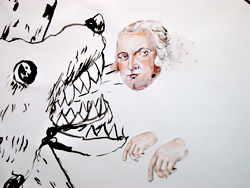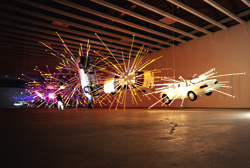Imagine an elegant 18th-century garden party of coiffed courtesans and powdered gentlemen invaded by a pack of marauding bloodhounds. This is the sort of imagery that fills and bursts through the frames of local artist Dawn Cerny’s latest menagerie of drawings and watercolors, “Schönbrunn (A Failed Attempt at Something Grand).” Cerny clearly has no respect for boundaries—literal, as in the confines of a picture frame, or historical and contextual. She perversely superimposes coarse activities like hunting over effete bourgeois portraiture, offering a provocative commentary on social facades. All of which makes her current work such a jolly good romp. Black silhouette tears drip from a pair of male cameos, pinned to the wall, to great 3-D effect, like a cascade of preserved butterflies—delightfully mocking the solemnity of Victorian mourning art. Carefully cut-out trees continue to grow past the top of the frame in Russia! Cerny’s interest in taking stuffy tradition to its logical and absurd conclusion is evidenced in the title of the fictional portrait, Louis XVIXXIIIVIVIIIXVI. German critic Walter Benjamin’s expansive and idiosyncratic book, Das Passagen-Werk, or The Arcades Project (begun in 1927 Paris), is her point of departure. The pretty glass arcades connecting 19th century Parisian shops were the precursor to the modern shopping mall—and the beginning of the end of small-town sensibilities. “When I first came across this book, I had already been thinking a lot about museums and the way they started, at least in the Age of Enlightenment, [and] how, if we could now perceive the world and history as if we didn’t know all, things could be twisted and manipulated or relived in a new light.” Though a sociological study of consumerism and modernity, Arcades is first and foremost the kaleidoscopic compendium of one man’s lifetime of thought. This is also a good way to interpret Cerny’s diversely
entangled work, executed with both acute precision and exhilarating abandon.
Q&A With Dawn Cerny
Seattle Weekly: What is it about Walter Benjamin and his Arcades Project that appeals or speaks to you? Do you find yourself relating more to his work, or to him and the mind-set behind the Arcades endeavor? How is your current work related to it?

Dawn Cerny: The Arcades Project strikes me as having this perfect balance between a highly intellectual, sociological investigation and a magical encyclopedia of a man’s collection of ideas. When I first came across this book, I had already been thinking a lot about museums and the way they started (at least) in the Age of Enlightenment. [About] how, if we could (now) perceive the world and history, as if we didn’t know all, things could be twisted and manipulated or relived in a new light.
My experience with this book continues to be (as it does with lots of people) a labyrinth that keeps exposing new layers of who we have been and who we are now. The story I told myself when I started this whole thing was that Benjamin was a kind of prophet and used this collection of other people’s thinking to tell his story. This show was also an attempt to appropriate other people’s work and try to skirt around heavy-handed contemporary issues by adopting a kind of historical sleight-of-hand trick. By adopting the stance that “this happened a long time ago” and “none of us were there,” I find I have a nice amount of space to pivot between the cerebral (academic) and magical (storytelling).
Does the title of your show relate to your efforts in making this work—or the efforts and failures of the characters you depict?
The title of the show, “Schönbrunn,” refers to the Austrian palace that always seems to be referred to as the “Versailles of Austria,” rather than an important building in its own right. [It refers to] how, in its own history, Schönbrunn was constantly being changed and updated depending on who was living there at the time and what the fads were. (Incidentally, hunting seemed to be the only constant in its history.) I felt that this title represented both the grandeur of what I was striving for but also left room to recognizing the nature of my humble (maybe even pathetic?) attempt at something I feel so intellectually ill-equipped to tackle.
How do you feel about picture frames? At one point I thought you might rather do away with them but, on second thought, felt you in fact enjoy having the framework to break out of and play with. Which is correct? Maybe both?
As a printmaker, I am always having to consider the “plate mark” or the limits of the borders of the paper. I am going through a little rebellious phase where I resent these limitations and thus I am trying to find tricky ways to push things off the edges. The same goes for frames. I resent that paper, so gorgeous, and also trashy, has to be protected. I love that the frame can make something that is seemingly worthless have value, but I resent that for something to have market value (especially paper), it needs to be protected in a frame. I think you were dead-on when you picked up on my love/hate relationship to framing—ultimately, I think that I am going to have to think a lot more like a sculptor if I want to find some reconciliation.
Who are the two fellows in black silhouette (cameo) shedding tears—and why?
The silhouettes are an element I, yet again, opt for as a theatrical device. They both look like “someones” but aren’t [and] act for me as the chorus. They’re also a nod to Victorian sentimentality, specifically that of mourning art and all that entails—ritual and protocol for a society ruminating in death as opposed to the sexual rumination of today—and all that might imply.
How do you explain your fascination with these sickly centuries of yore?
I think I like the portraits as milestones of fashion. Here, these paintings were once hip and contemporary. Then they were old—in a pleated pantsuit kind of way. Now, they are revered as something historical; something that only the rich, yet again, can have.








